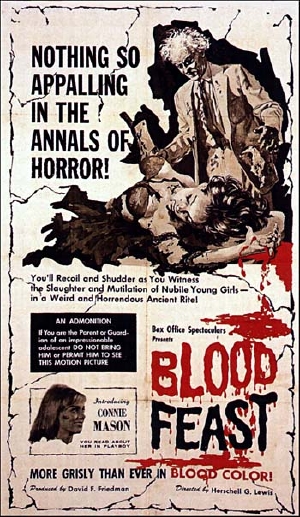What is it about H.G. Lewis’s flicks that are so much fun? They’re not “good” by any stretch of the imagination—indeed, they’re often downright atrocious. Case in point: BLOOD FEAST, the first of Lewis’ gore epics, which freaked out quite a few drive-in patrons during its initial run. These days, obviously, it’s not nearly as horrifying; it’s downright campy, in fact, but that’s a large part of its allure. Ridiculous it may be, but it’s also fun.
BLOOD FEAST apparently came about because its creators, the late writer-director-cinematographer Herschell Gordon Lewis and producer David F. Friedman, had grown disenchanted with the “nudie cutie” and “roughie” features they had been churning out, and wanted to find a new market to exploit. The result was the world’s first splatter film.
It caused widespread shock, revulsion and even vomiting during its 1963 release on the drive-in circuit (making it the down-market equivalent of PSYCHO). BLOOD FEAST was also instrumental in establishing a thriving exploitation film scene in Florida (even though it was actually conceived in Chicago, from which Lewis and Friedman relocated because the weather there was too cold).
Lewis—upon whom the title “Godfather of gore” was bestowed due to BLOOD FEAST—and Friedman went on to finish out their gore trilogy with TWO THOUSAND MANIACS! (1964) and COLOR ME BLOOD RED (1965) before going their separate ways. As for BLOOD FEAST 2: ALL U CAN EAT, it was a digitally shot production that appeared in 2002, nearly forty years after the original BLOOD FEAST, but it wasn’t nearly as much fun.
In a small Florida community a psychotic killer is on the loose. One of his first victims is Gloria Schippers, a housefrow who gets stabbed through an eyeball in her bathtub, prior to both her legs being amputated.
Fuad Ramses is the killer, an Egyptian creep who runs a novelty shop. He’s asked by the society gal Dorothy Fremont to cook an exotic dinner for her daughter Suzette. Fuad agrees, promising to prepare a feast like those enjoyed by the ancient Egyptians, who regularly indulged in human sacrifice and cannibalism. What Dorothy doesn’t realize is that Fuad is entirely serious about those last two points, and endeavors to carry them out to the letter.
He kills again, with his victims being a young woman on a beach, whose brain he filches from her skull, and another residing in a motel, whose tongue he rips out, and yet another, whose heart he makes off with. A fifth woman is subjected to prolonged whipping, apparently to tenderize her flesh before Fuad dismembers and cooks it.
The cops, meanwhile, are investigating the murders. In the process one of those cops, Peter Thornton, commences a sappy romance with Dorothy Fremont’s daughter Suzette.
The day of Suzette’s party arrives. Fuad turns up with his “feast,” which he plans to complete with the flesh of Suzette. But just as he’s about to do her in he’s caught in the act by Dorothy, and runs off. He’s pursued by Thornton to the town dump, where Fuad tries to hide out in the back of a dump truck—just as it’s about to grind up its contents. Bad idea!
Yes, this film is every bit as tawdry as can be imagined, with lingering close-ups that only point up how incredibly primitive the gore effects are (the whipping scene is the only one that retains a fraction of its initial unpleasantness). Note also the absence of nudity or four-letter words, which, as was hoped, caught the ratings board unawares.
Lewis pads his 67-minute running time with much extraneous footage (the climactic sequence of Ramses running through the junkyard is dragged out interminably), making BLOOD FEAST feel a helluva lot longer than its 67 minute run time. Yet the close-ups of Fuad Ramsey’s fevered eyes before he kills are priceless, as is much of the acting (one guy is constantly looking at his hand, apparently because he couldn’t remember his lines and they were written on his palm).
The performances are so inept, in fact, that they achieve a kind of surreal grace. Acting was admittedly a secondary concern of Lewis, who has subsequently claimed that “as we battled for theatrical playing time against major company productions, showmanship and exploitation values were paramount. Acting talent ran a poor third.”
There’s also the rudimentary music score, accomplished by Lewis himself. Particularly memorable is the organ music that plays over the killings, giving the proceedings the feel of an especially demented silent film.
The result is a thoroughly bizarre film containing more than a hint of the surreal loopiness of the oeuvre of Lewis’ trash movie contemporary Ray Dennis Steckler. Trend-setting it may have been, but to this day you simply won’t find another movie quite like BLOOD FEAST.
Vital Statistics
BLOOD FEAST
Box-Office Spectaculars, Inc.
Director: Herschell Gordon Lewis
Producer: David F. Friedman
Screenplay: A. Louise Downe
Cinematography: Herschell Gordon Lewis
Editing: Frank Romolo, Robert Sinise
Cast: “Thomas Wood” (William Kerwin), Mal Arnold, Connie Mason, Lyn Bolton, Scott H. Hall, Christy Foushee, Ashlyn Martin, Astrid Olson, Sandra Sinclair, Gene Courtier, Louise Kamp, Hal Rich

